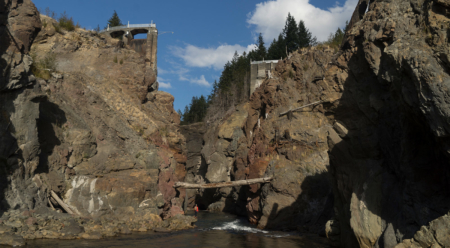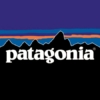About Our Wilder Waters Collection
Patagonia is an unusual workplace in many ways, and the fact that employees are encouraged to incorporate environmental activism into their daily work is just one of the characteristics that sets our company apart. The realities of running a business are important, but we’re always aware that our business has to serve the more pressing goal of keeping our planet habitable in the present and the future.
The third clause of Patagonia’s mission statement asks us “to inspire and implement solutions to the environmental crisis.” We’re all still learning to act on that in our own ways, and for Chris Teig, our Director of Graphics and Illustration, it has recently meant incorporating more art-based activism into the colors, textiles and graphics that appear on our clothing. Including six T-shirt designs and a range of patterns and prints, the new Wilder Waters collection is one of the first results. Paying tribute to the important work of dam removal and river restoration, the Wilder Waters artwork began with a trip to the Elwha River in Washington State, the site of the world’s largest dam removal project to date.
Healthy, undammed rivers—like the recently freed Elwha—are the arteries that keep our planet’s circulatory system alive, and it’s Chris’ hope that this collection will help inspire more people to support river restoration and rewilding projects in their own backyards.
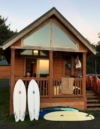
Chris Teig watches the sun set after a fun session at Hobuck Beach. The team spent an evening on the Makah Reservation where they caught great surf, cooked halibut over the campfire and prepared to explore the Elwha River. Neah Bay, Washington. Photo: Lauren Tasugi
There’s no art without imagination, but this collection began at a very real and specific place. Why did you choose a trip to the Elwha as a starting point?
Most environmental issues are super depressing, and they almost seem to make people even less convinced that change can happen. The Elwha restoration is a massive effort that began with the removal of two huge dams, and it’s still ongoing with smaller projects like the re-introduction of native plant species and the construction of debris fields to protect salmon smolts. It’s been a massive success story, and we wanted to celebrate the achievement through the art in the Wilder Waters collection. It’s a story of hope, and our goal is to inspire more dam removal and river restoration around the world.

An aerial view of the Glines Canyon dam site. The bed of Lake Mills, the reservoir created by the dam when construction was completed in 1927, is now being restored and revegetated. Photo: Mark McInnis
Patagonia has produced plenty of graphics over the years that highlight particular issues. With Wilder Waters, how did you hope to advance the environmental aspects of your work?
I think the company does an amazing job at improving the social and environmental aspects of manufacturing, but those of us in the art department saw an opportunity to add another layer of activism. We wanted to see what would happen if we sent a group of designers to an environmental hotspot, rather than taking seasonal inspiration from art trends or retail markets. The designers and their work were super inspired by the experience, and the collection began to have a more cohesive voice as they worked on the art. Most us came to Patagonia to have a direct influence on the environmental crisis, and with this collection it felt like we could really make change with the art we were creating.
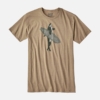
From misty mountains to salty sea, the influence of a river reaches well beyond its banks. Removing dams helps restore natural sediment flow, and the formation of new sandbars promises long, peeling waves on the best days of the year. But guess what? The locals were here first, they’re always on it, and they demand respect. Featured: Men’s Pods On It Cotton/Poly T-Shirt
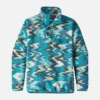
Rivers aren’t only ecosystems: They’re also places of culture and memory. In honor of the stories that remind us what we must work to protect, the Trout Tales print is based on the traditional weaving arts of the Pacific Northwest. Featured: Women’s Lightweight Synchilla® Snap-T® Fleece Pullover
What was the most vivid aspect of the Elwha trip for you?
It’s really amazing how quickly the river has rebounded. When we walked into one of the former Elwha dam sites, at first it was hard to even see where the dam had been. We were all blown away by how wild the river had already become. Patagonia was instrumental in the dam removals, so we all felt like somehow we’d played a small role in bringing this river back. It was a proud moment.
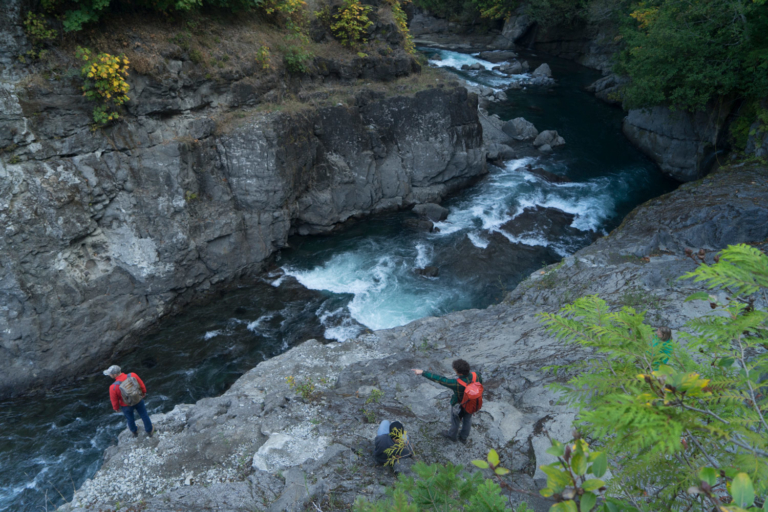
The Elwha Dam was a true deadbeat dam—when construction began in 1910, its builders failed to provide any way for fish to pass. Now, barely any trace of it remains, and the river runs free once more. It’s a success story that will hopefully be repeated on many more rivers around the world. Photo: Mark McInnis
After your trip, what was the design process like?
We wanted to narrow in on a few themes that would give a consistent direction to the collection, so we focused on running water, salmon and the flora and fauna of the Olympic Peninsula. The Patagonia textile team creates art in-house, by hand, so we can really go after these themes in an authentic way. For the T-shirts, we wanted to create and source artwork that connected to the Pacific Northwest, but still conveys a message that matters everywhere. In this case, it was taking inspiration from the success of the Elwha to promote river restoration around the globe.
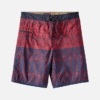
Since time immemorial, salmon have been a primary source of sustenance for those living along the coasts and rivers of the Pacific Northwest. The repeating Indigo Fish print celebrates how wild waters provide habitat for the keystone species that so faithfully bring us life. Featured: Men’s Wavefarer® Boardshorts
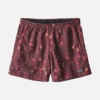
Our geometric Wish Tails pattern was originally inspired by the streamlined tails of returning salmon. The removal of Washington’s Elwha dams has allowed wild salmon to reclaim their traditional spawning habitat in the upper river. Featured: Women’s Baggies™ Shorts
What action do you hope people will take to help restore rivers in their own areas?
I think we need to win the battle of apathy first. If people see that change can happen, it opens up all sorts of possibilities. And that’s the beauty of the Elwha story. It doesn’t hurt that the beauty of the area has been greatly enhanced by the dam removals—and that’s probably the biggest motivation to get people to support river rewilding in their backyards.
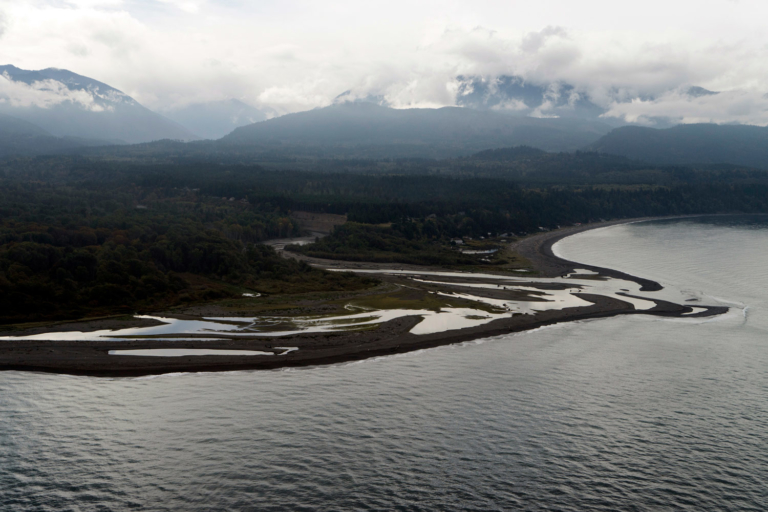
For over a century, the Elwha dams blocked the river’s conveyer belt of natural sediment. With the river now running free to the sea, the rivermouth and nearshore environments are bouncing back. Photo: Mark McInnis
Are you planning more initiatives like Wilder Waters that connect art and activism?
Absolutely. It’s an approach that not only inspires great work from the design teams, but it also creates opportunities for our design and environmental teams to collaborate on projects that can make real change in the world. We’ve already got two more seasons coming up, next spring and next fall, with visual themes based on specific environmental issues.
Wilder Waters prints and graphics can be found throughout the new fall 2017 line. Visit patagonia.com or your nearest Patagonia Retail Store to see them firsthand.
